IKEA's HRM Practices and Work Culture: A Comprehensive Report
VerifiedAdded on 2023/04/20
|24
|8652
|484
Report
AI Summary
This report examines IKEA's human resource management practices, focusing on how the company's policies contribute to its success and employee satisfaction. The report employs a case study research strategy, analyzing IKEA's HRM policies and their impact on employee retention and development. It explores the importance of a positive work culture, employee development programs, and cultural elements that foster innovation and retention. The methodology includes an analysis of research philosophy, approach, design, and strategy, along with data collection methods. The literature review covers the importance of strong HRM policies, work culture's impact on morale, and the key elements of IKEA's HRM. The report concludes with recommendations for further enhancing IKEA's HRM practices, aiming to maintain and improve employee satisfaction and organizational performance. The study emphasizes the significance of employee recognition and the development of effective HRM strategies within the organization.
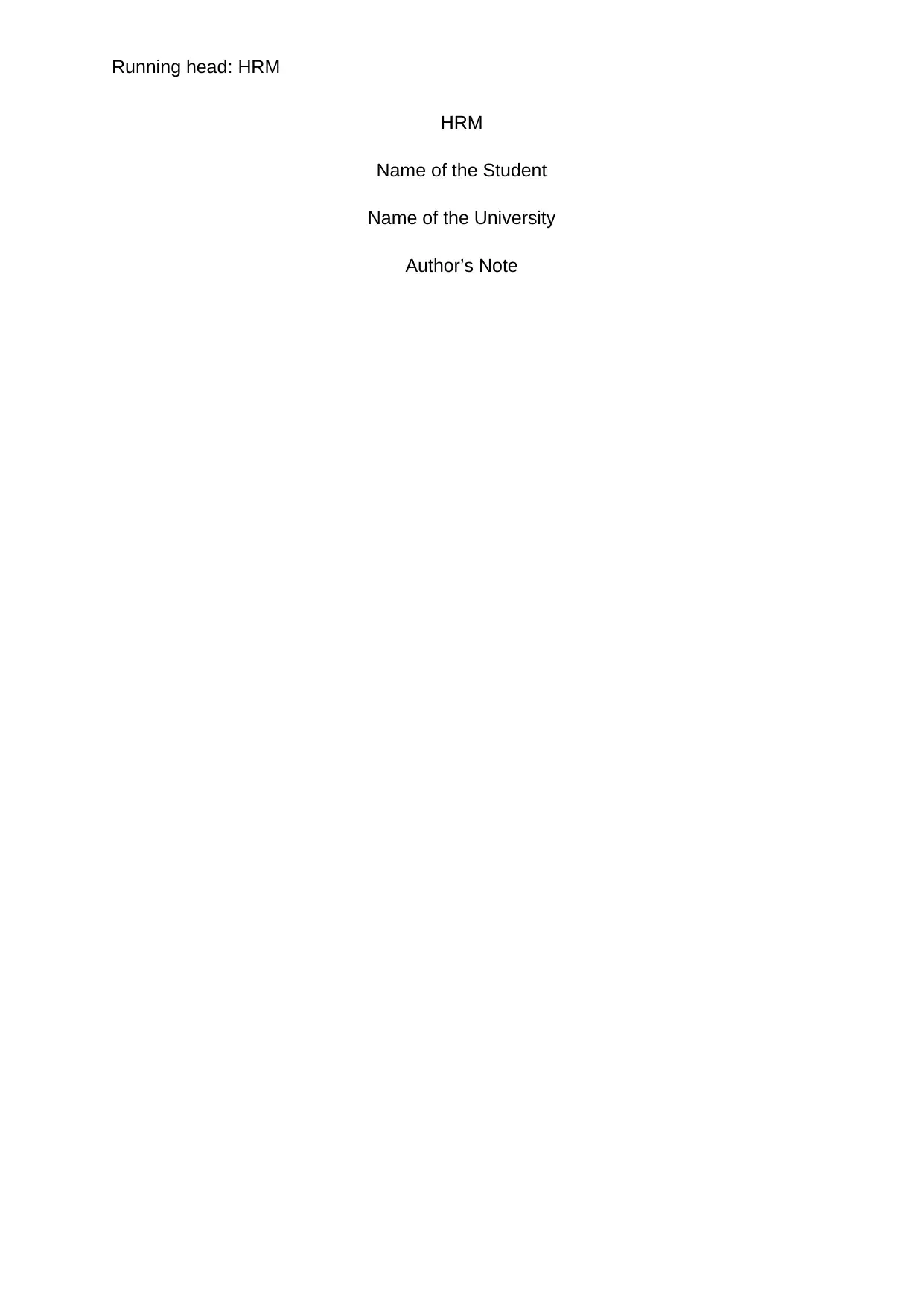
Running head: HRM
HRM
Name of the Student
Name of the University
Author’s Note
HRM
Name of the Student
Name of the University
Author’s Note
Paraphrase This Document
Need a fresh take? Get an instant paraphrase of this document with our AI Paraphraser
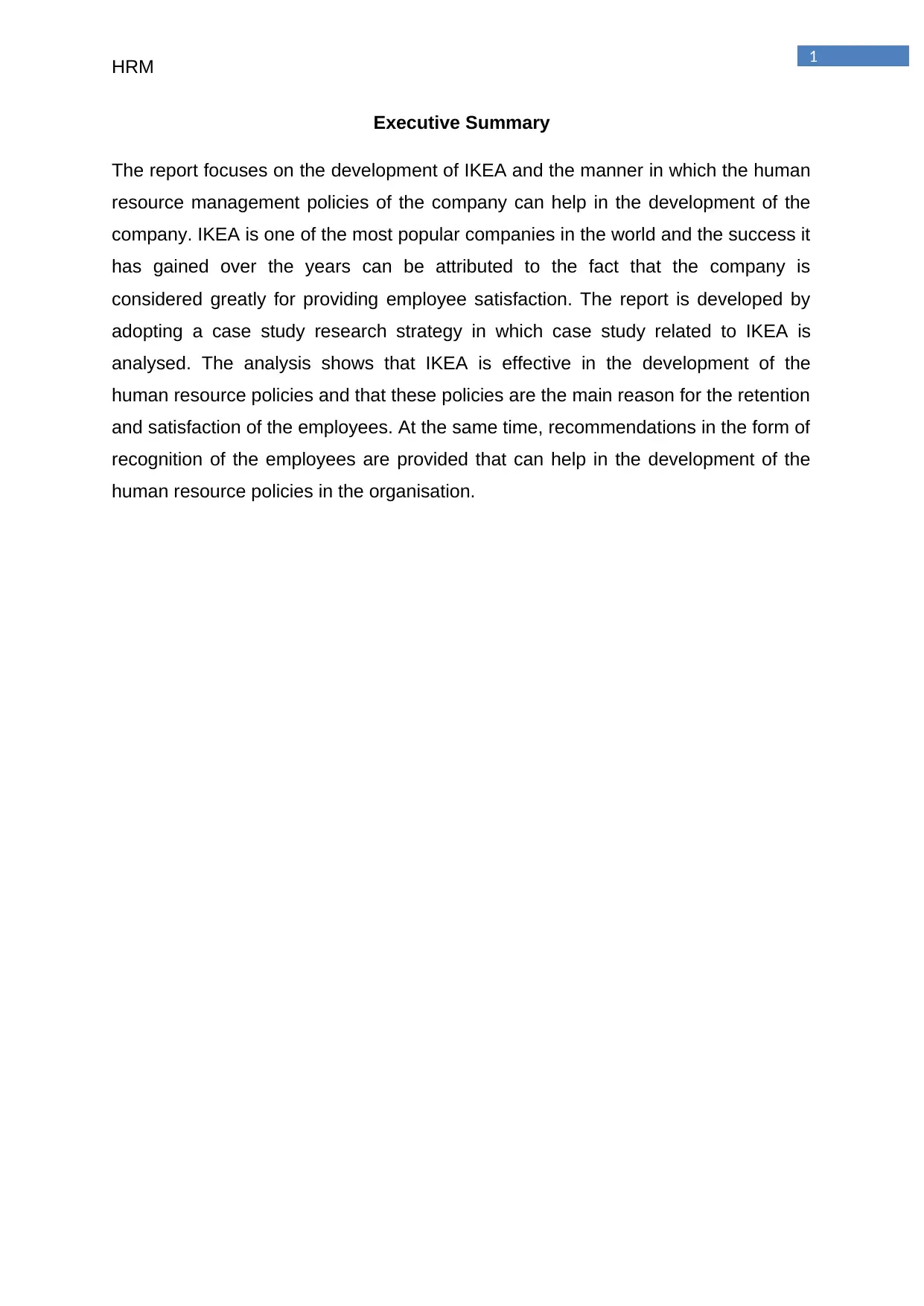
1
HRM
Executive Summary
The report focuses on the development of IKEA and the manner in which the human
resource management policies of the company can help in the development of the
company. IKEA is one of the most popular companies in the world and the success it
has gained over the years can be attributed to the fact that the company is
considered greatly for providing employee satisfaction. The report is developed by
adopting a case study research strategy in which case study related to IKEA is
analysed. The analysis shows that IKEA is effective in the development of the
human resource policies and that these policies are the main reason for the retention
and satisfaction of the employees. At the same time, recommendations in the form of
recognition of the employees are provided that can help in the development of the
human resource policies in the organisation.
HRM
Executive Summary
The report focuses on the development of IKEA and the manner in which the human
resource management policies of the company can help in the development of the
company. IKEA is one of the most popular companies in the world and the success it
has gained over the years can be attributed to the fact that the company is
considered greatly for providing employee satisfaction. The report is developed by
adopting a case study research strategy in which case study related to IKEA is
analysed. The analysis shows that IKEA is effective in the development of the
human resource policies and that these policies are the main reason for the retention
and satisfaction of the employees. At the same time, recommendations in the form of
recognition of the employees are provided that can help in the development of the
human resource policies in the organisation.
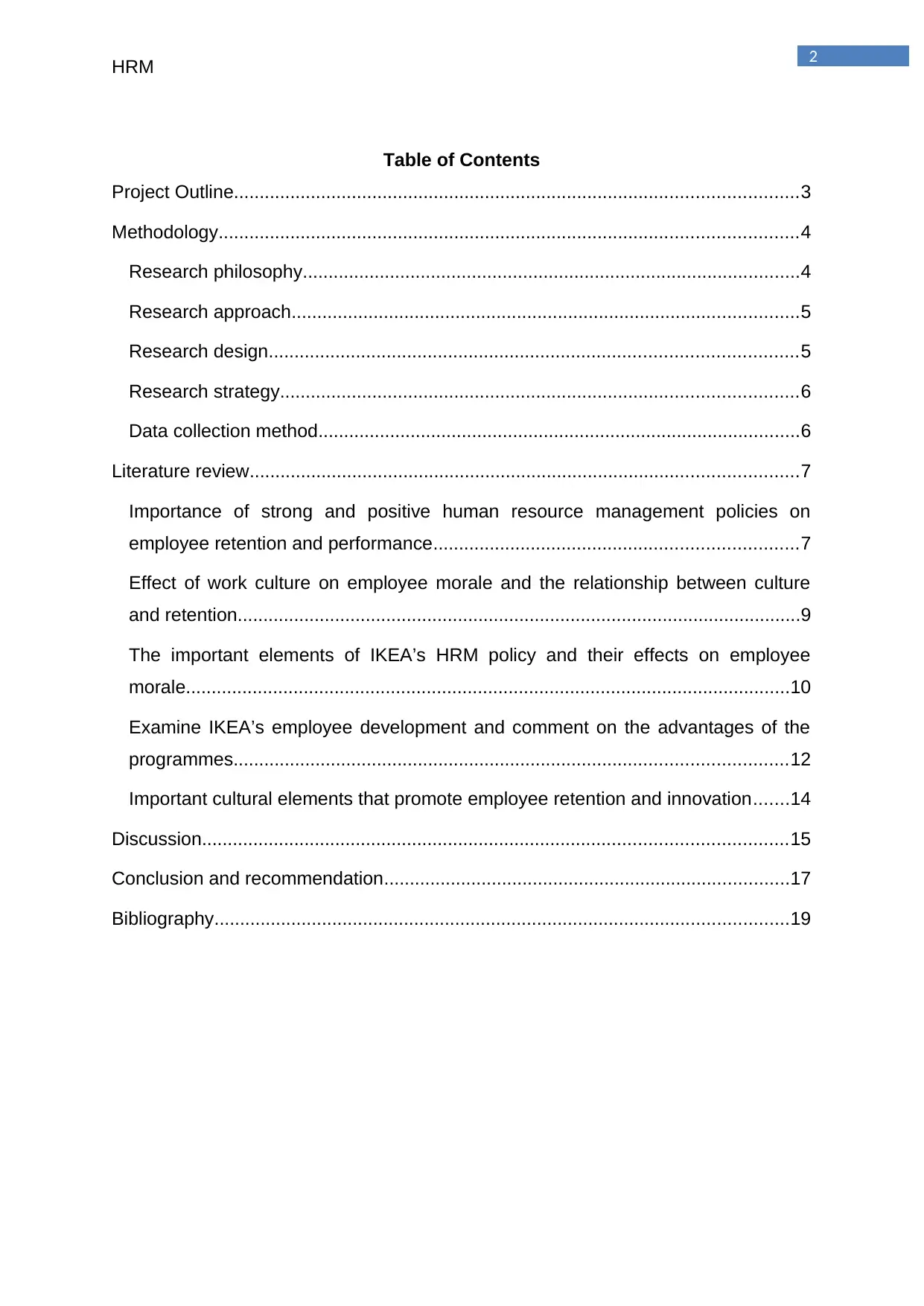
2
HRM
Table of Contents
Project Outline..............................................................................................................3
Methodology.................................................................................................................4
Research philosophy.................................................................................................4
Research approach...................................................................................................5
Research design.......................................................................................................5
Research strategy.....................................................................................................6
Data collection method..............................................................................................6
Literature review...........................................................................................................7
Importance of strong and positive human resource management policies on
employee retention and performance.......................................................................7
Effect of work culture on employee morale and the relationship between culture
and retention..............................................................................................................9
The important elements of IKEA’s HRM policy and their effects on employee
morale......................................................................................................................10
Examine IKEA’s employee development and comment on the advantages of the
programmes............................................................................................................12
Important cultural elements that promote employee retention and innovation.......14
Discussion..................................................................................................................15
Conclusion and recommendation...............................................................................17
Bibliography................................................................................................................19
HRM
Table of Contents
Project Outline..............................................................................................................3
Methodology.................................................................................................................4
Research philosophy.................................................................................................4
Research approach...................................................................................................5
Research design.......................................................................................................5
Research strategy.....................................................................................................6
Data collection method..............................................................................................6
Literature review...........................................................................................................7
Importance of strong and positive human resource management policies on
employee retention and performance.......................................................................7
Effect of work culture on employee morale and the relationship between culture
and retention..............................................................................................................9
The important elements of IKEA’s HRM policy and their effects on employee
morale......................................................................................................................10
Examine IKEA’s employee development and comment on the advantages of the
programmes............................................................................................................12
Important cultural elements that promote employee retention and innovation.......14
Discussion..................................................................................................................15
Conclusion and recommendation...............................................................................17
Bibliography................................................................................................................19
⊘ This is a preview!⊘
Do you want full access?
Subscribe today to unlock all pages.

Trusted by 1+ million students worldwide
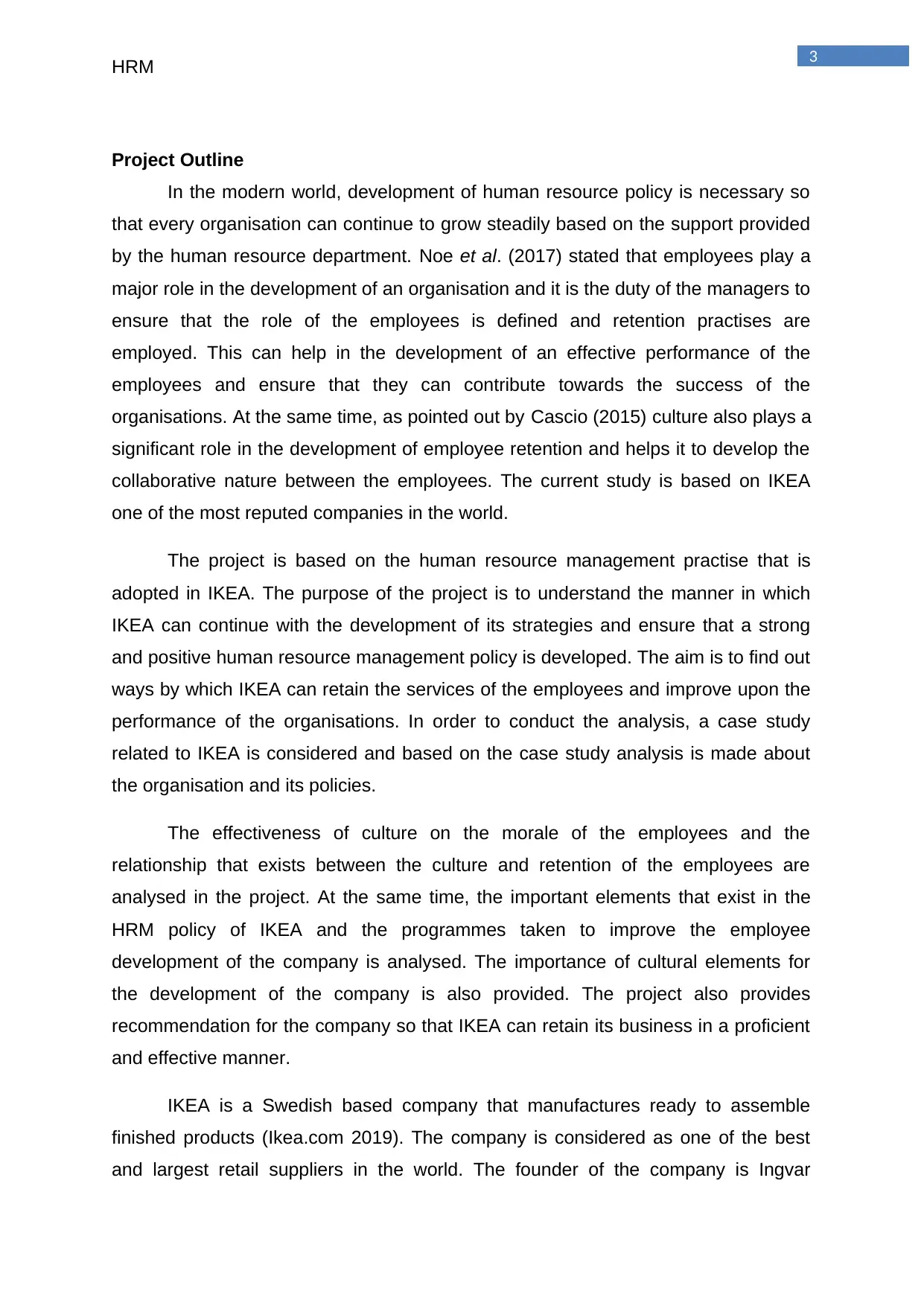
3
HRM
Project Outline
In the modern world, development of human resource policy is necessary so
that every organisation can continue to grow steadily based on the support provided
by the human resource department. Noe et al. (2017) stated that employees play a
major role in the development of an organisation and it is the duty of the managers to
ensure that the role of the employees is defined and retention practises are
employed. This can help in the development of an effective performance of the
employees and ensure that they can contribute towards the success of the
organisations. At the same time, as pointed out by Cascio (2015) culture also plays a
significant role in the development of employee retention and helps it to develop the
collaborative nature between the employees. The current study is based on IKEA
one of the most reputed companies in the world.
The project is based on the human resource management practise that is
adopted in IKEA. The purpose of the project is to understand the manner in which
IKEA can continue with the development of its strategies and ensure that a strong
and positive human resource management policy is developed. The aim is to find out
ways by which IKEA can retain the services of the employees and improve upon the
performance of the organisations. In order to conduct the analysis, a case study
related to IKEA is considered and based on the case study analysis is made about
the organisation and its policies.
The effectiveness of culture on the morale of the employees and the
relationship that exists between the culture and retention of the employees are
analysed in the project. At the same time, the important elements that exist in the
HRM policy of IKEA and the programmes taken to improve the employee
development of the company is analysed. The importance of cultural elements for
the development of the company is also provided. The project also provides
recommendation for the company so that IKEA can retain its business in a proficient
and effective manner.
IKEA is a Swedish based company that manufactures ready to assemble
finished products (Ikea.com 2019). The company is considered as one of the best
and largest retail suppliers in the world. The founder of the company is Ingvar
HRM
Project Outline
In the modern world, development of human resource policy is necessary so
that every organisation can continue to grow steadily based on the support provided
by the human resource department. Noe et al. (2017) stated that employees play a
major role in the development of an organisation and it is the duty of the managers to
ensure that the role of the employees is defined and retention practises are
employed. This can help in the development of an effective performance of the
employees and ensure that they can contribute towards the success of the
organisations. At the same time, as pointed out by Cascio (2015) culture also plays a
significant role in the development of employee retention and helps it to develop the
collaborative nature between the employees. The current study is based on IKEA
one of the most reputed companies in the world.
The project is based on the human resource management practise that is
adopted in IKEA. The purpose of the project is to understand the manner in which
IKEA can continue with the development of its strategies and ensure that a strong
and positive human resource management policy is developed. The aim is to find out
ways by which IKEA can retain the services of the employees and improve upon the
performance of the organisations. In order to conduct the analysis, a case study
related to IKEA is considered and based on the case study analysis is made about
the organisation and its policies.
The effectiveness of culture on the morale of the employees and the
relationship that exists between the culture and retention of the employees are
analysed in the project. At the same time, the important elements that exist in the
HRM policy of IKEA and the programmes taken to improve the employee
development of the company is analysed. The importance of cultural elements for
the development of the company is also provided. The project also provides
recommendation for the company so that IKEA can retain its business in a proficient
and effective manner.
IKEA is a Swedish based company that manufactures ready to assemble
finished products (Ikea.com 2019). The company is considered as one of the best
and largest retail suppliers in the world. The founder of the company is Ingvar
Paraphrase This Document
Need a fresh take? Get an instant paraphrase of this document with our AI Paraphraser
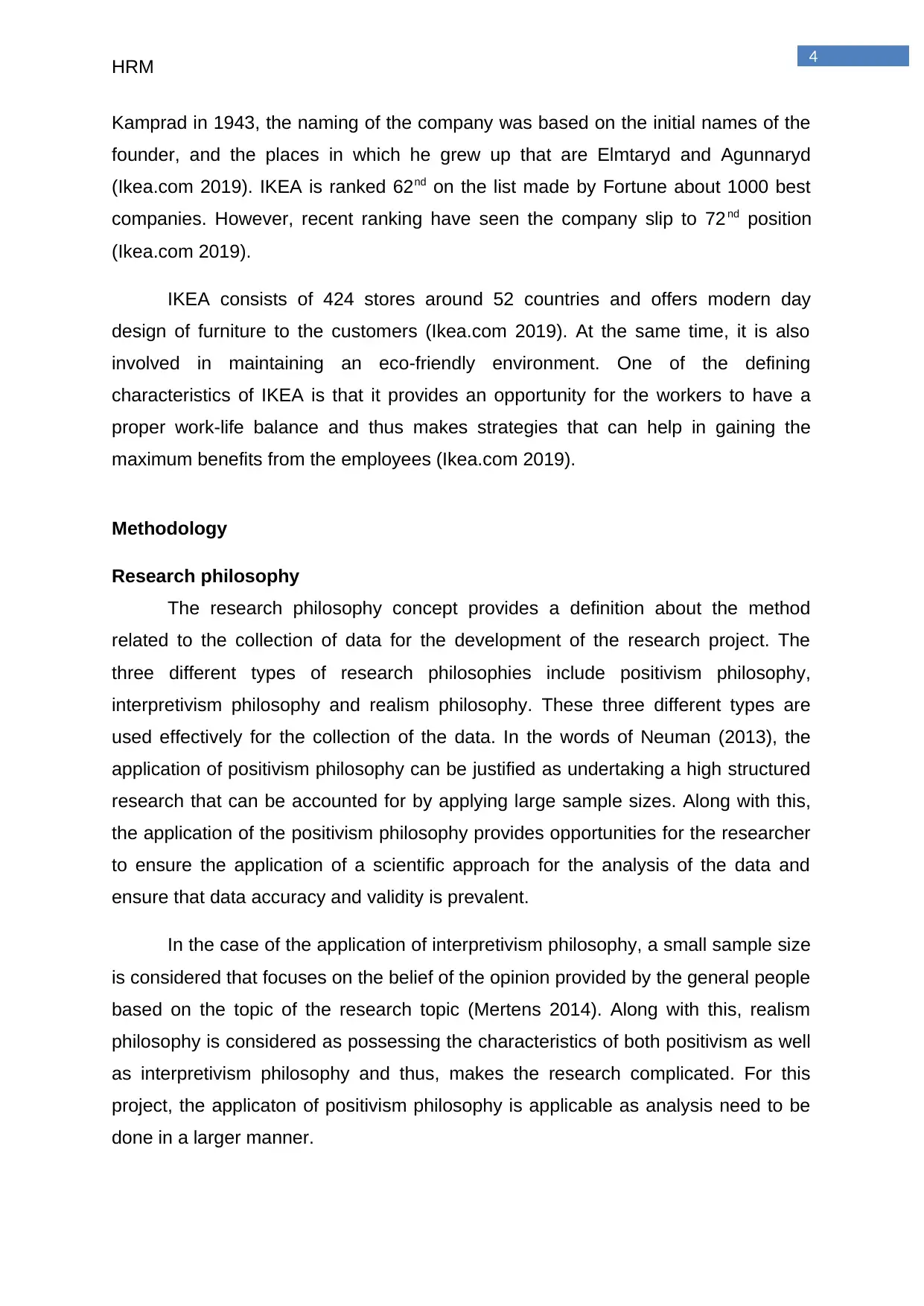
4
HRM
Kamprad in 1943, the naming of the company was based on the initial names of the
founder, and the places in which he grew up that are Elmtaryd and Agunnaryd
(Ikea.com 2019). IKEA is ranked 62nd on the list made by Fortune about 1000 best
companies. However, recent ranking have seen the company slip to 72nd position
(Ikea.com 2019).
IKEA consists of 424 stores around 52 countries and offers modern day
design of furniture to the customers (Ikea.com 2019). At the same time, it is also
involved in maintaining an eco-friendly environment. One of the defining
characteristics of IKEA is that it provides an opportunity for the workers to have a
proper work-life balance and thus makes strategies that can help in gaining the
maximum benefits from the employees (Ikea.com 2019).
Methodology
Research philosophy
The research philosophy concept provides a definition about the method
related to the collection of data for the development of the research project. The
three different types of research philosophies include positivism philosophy,
interpretivism philosophy and realism philosophy. These three different types are
used effectively for the collection of the data. In the words of Neuman (2013), the
application of positivism philosophy can be justified as undertaking a high structured
research that can be accounted for by applying large sample sizes. Along with this,
the application of the positivism philosophy provides opportunities for the researcher
to ensure the application of a scientific approach for the analysis of the data and
ensure that data accuracy and validity is prevalent.
In the case of the application of interpretivism philosophy, a small sample size
is considered that focuses on the belief of the opinion provided by the general people
based on the topic of the research topic (Mertens 2014). Along with this, realism
philosophy is considered as possessing the characteristics of both positivism as well
as interpretivism philosophy and thus, makes the research complicated. For this
project, the applicaton of positivism philosophy is applicable as analysis need to be
done in a larger manner.
HRM
Kamprad in 1943, the naming of the company was based on the initial names of the
founder, and the places in which he grew up that are Elmtaryd and Agunnaryd
(Ikea.com 2019). IKEA is ranked 62nd on the list made by Fortune about 1000 best
companies. However, recent ranking have seen the company slip to 72nd position
(Ikea.com 2019).
IKEA consists of 424 stores around 52 countries and offers modern day
design of furniture to the customers (Ikea.com 2019). At the same time, it is also
involved in maintaining an eco-friendly environment. One of the defining
characteristics of IKEA is that it provides an opportunity for the workers to have a
proper work-life balance and thus makes strategies that can help in gaining the
maximum benefits from the employees (Ikea.com 2019).
Methodology
Research philosophy
The research philosophy concept provides a definition about the method
related to the collection of data for the development of the research project. The
three different types of research philosophies include positivism philosophy,
interpretivism philosophy and realism philosophy. These three different types are
used effectively for the collection of the data. In the words of Neuman (2013), the
application of positivism philosophy can be justified as undertaking a high structured
research that can be accounted for by applying large sample sizes. Along with this,
the application of the positivism philosophy provides opportunities for the researcher
to ensure the application of a scientific approach for the analysis of the data and
ensure that data accuracy and validity is prevalent.
In the case of the application of interpretivism philosophy, a small sample size
is considered that focuses on the belief of the opinion provided by the general people
based on the topic of the research topic (Mertens 2014). Along with this, realism
philosophy is considered as possessing the characteristics of both positivism as well
as interpretivism philosophy and thus, makes the research complicated. For this
project, the applicaton of positivism philosophy is applicable as analysis need to be
done in a larger manner.
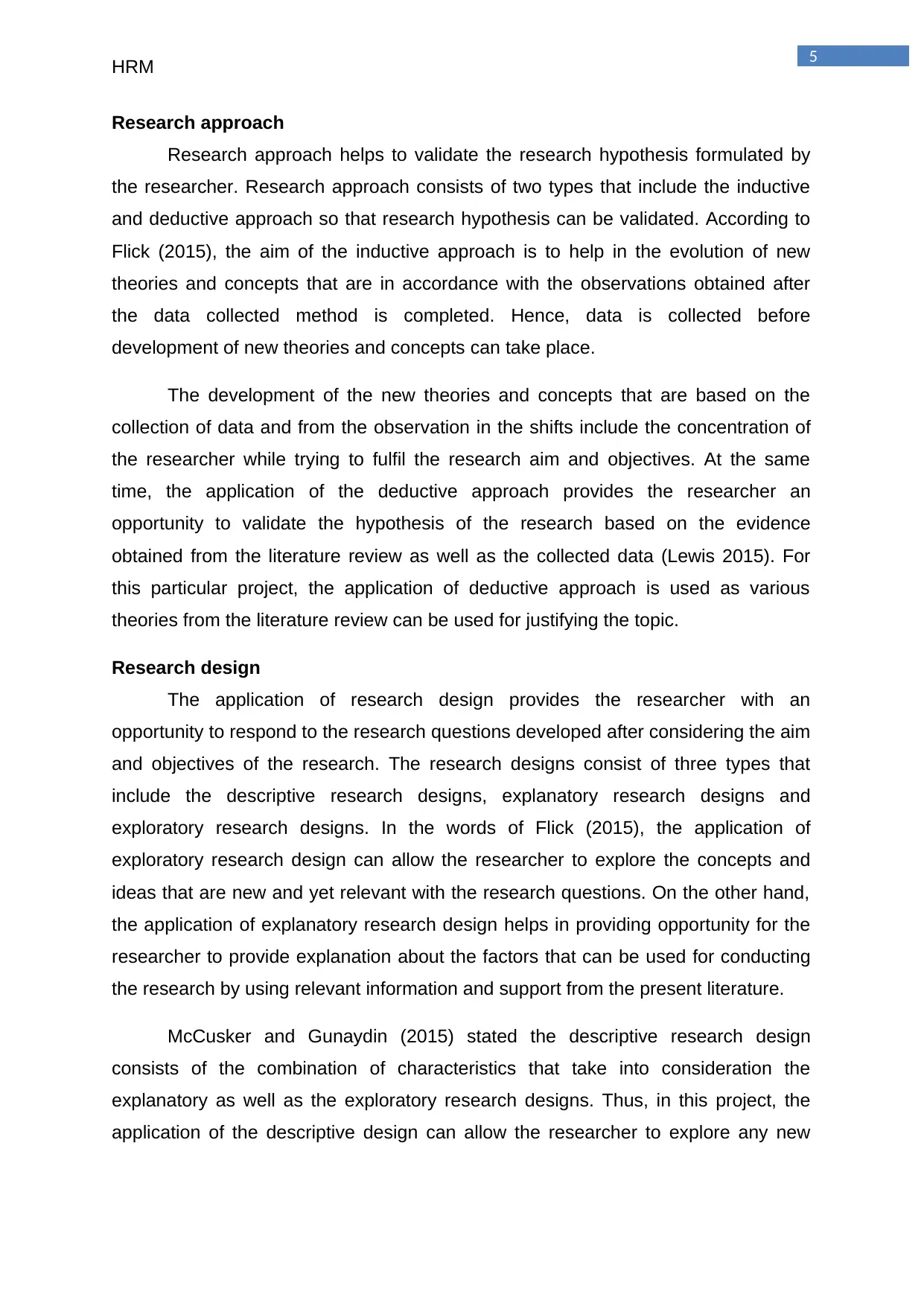
5
HRM
Research approach
Research approach helps to validate the research hypothesis formulated by
the researcher. Research approach consists of two types that include the inductive
and deductive approach so that research hypothesis can be validated. According to
Flick (2015), the aim of the inductive approach is to help in the evolution of new
theories and concepts that are in accordance with the observations obtained after
the data collected method is completed. Hence, data is collected before
development of new theories and concepts can take place.
The development of the new theories and concepts that are based on the
collection of data and from the observation in the shifts include the concentration of
the researcher while trying to fulfil the research aim and objectives. At the same
time, the application of the deductive approach provides the researcher an
opportunity to validate the hypothesis of the research based on the evidence
obtained from the literature review as well as the collected data (Lewis 2015). For
this particular project, the application of deductive approach is used as various
theories from the literature review can be used for justifying the topic.
Research design
The application of research design provides the researcher with an
opportunity to respond to the research questions developed after considering the aim
and objectives of the research. The research designs consist of three types that
include the descriptive research designs, explanatory research designs and
exploratory research designs. In the words of Flick (2015), the application of
exploratory research design can allow the researcher to explore the concepts and
ideas that are new and yet relevant with the research questions. On the other hand,
the application of explanatory research design helps in providing opportunity for the
researcher to provide explanation about the factors that can be used for conducting
the research by using relevant information and support from the present literature.
McCusker and Gunaydin (2015) stated the descriptive research design
consists of the combination of characteristics that take into consideration the
explanatory as well as the exploratory research designs. Thus, in this project, the
application of the descriptive design can allow the researcher to explore any new
HRM
Research approach
Research approach helps to validate the research hypothesis formulated by
the researcher. Research approach consists of two types that include the inductive
and deductive approach so that research hypothesis can be validated. According to
Flick (2015), the aim of the inductive approach is to help in the evolution of new
theories and concepts that are in accordance with the observations obtained after
the data collected method is completed. Hence, data is collected before
development of new theories and concepts can take place.
The development of the new theories and concepts that are based on the
collection of data and from the observation in the shifts include the concentration of
the researcher while trying to fulfil the research aim and objectives. At the same
time, the application of the deductive approach provides the researcher an
opportunity to validate the hypothesis of the research based on the evidence
obtained from the literature review as well as the collected data (Lewis 2015). For
this particular project, the application of deductive approach is used as various
theories from the literature review can be used for justifying the topic.
Research design
The application of research design provides the researcher with an
opportunity to respond to the research questions developed after considering the aim
and objectives of the research. The research designs consist of three types that
include the descriptive research designs, explanatory research designs and
exploratory research designs. In the words of Flick (2015), the application of
exploratory research design can allow the researcher to explore the concepts and
ideas that are new and yet relevant with the research questions. On the other hand,
the application of explanatory research design helps in providing opportunity for the
researcher to provide explanation about the factors that can be used for conducting
the research by using relevant information and support from the present literature.
McCusker and Gunaydin (2015) stated the descriptive research design
consists of the combination of characteristics that take into consideration the
explanatory as well as the exploratory research designs. Thus, in this project, the
application of the descriptive design can allow the researcher to explore any new
⊘ This is a preview!⊘
Do you want full access?
Subscribe today to unlock all pages.

Trusted by 1+ million students worldwide
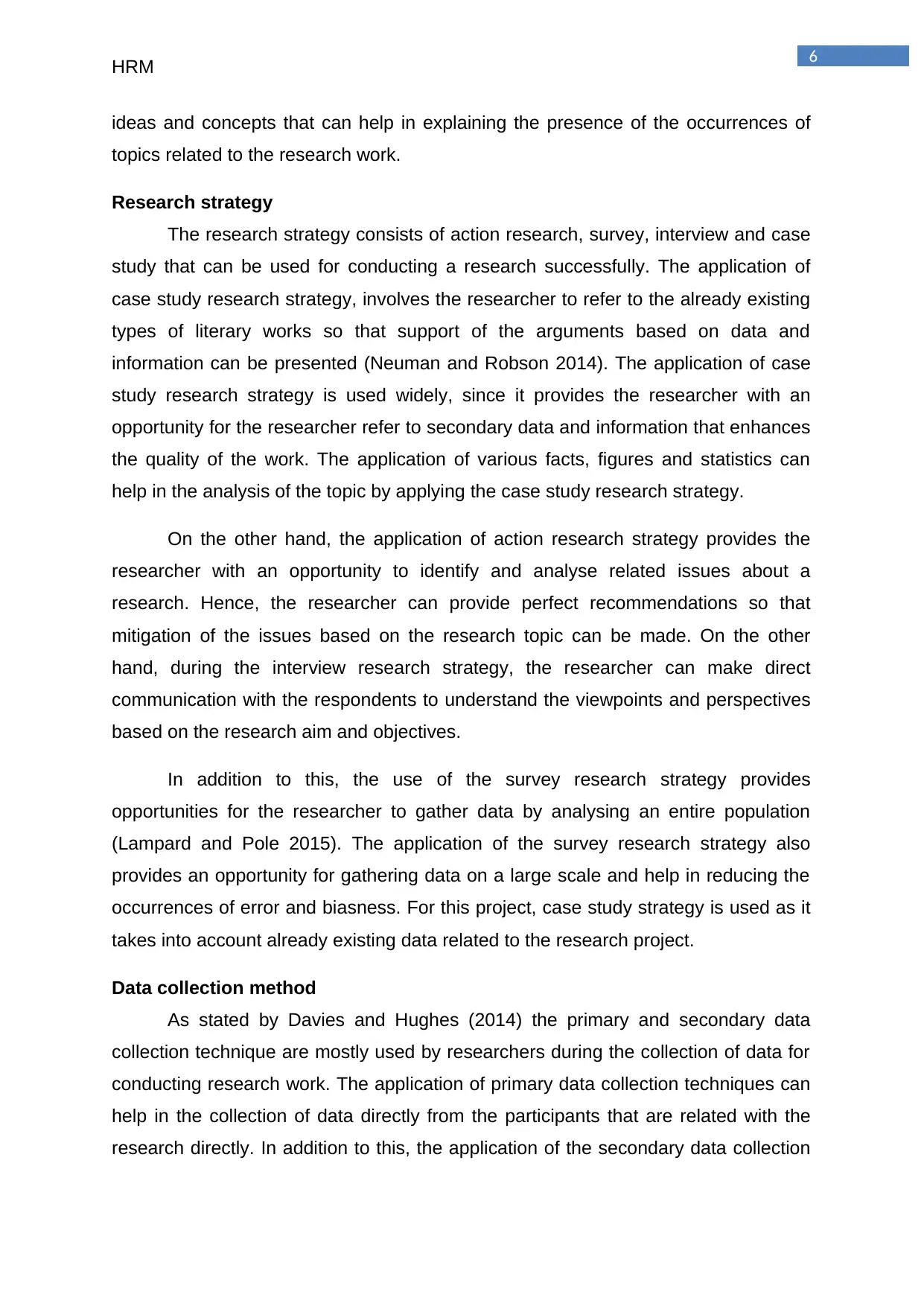
6
HRM
ideas and concepts that can help in explaining the presence of the occurrences of
topics related to the research work.
Research strategy
The research strategy consists of action research, survey, interview and case
study that can be used for conducting a research successfully. The application of
case study research strategy, involves the researcher to refer to the already existing
types of literary works so that support of the arguments based on data and
information can be presented (Neuman and Robson 2014). The application of case
study research strategy is used widely, since it provides the researcher with an
opportunity for the researcher refer to secondary data and information that enhances
the quality of the work. The application of various facts, figures and statistics can
help in the analysis of the topic by applying the case study research strategy.
On the other hand, the application of action research strategy provides the
researcher with an opportunity to identify and analyse related issues about a
research. Hence, the researcher can provide perfect recommendations so that
mitigation of the issues based on the research topic can be made. On the other
hand, during the interview research strategy, the researcher can make direct
communication with the respondents to understand the viewpoints and perspectives
based on the research aim and objectives.
In addition to this, the use of the survey research strategy provides
opportunities for the researcher to gather data by analysing an entire population
(Lampard and Pole 2015). The application of the survey research strategy also
provides an opportunity for gathering data on a large scale and help in reducing the
occurrences of error and biasness. For this project, case study strategy is used as it
takes into account already existing data related to the research project.
Data collection method
As stated by Davies and Hughes (2014) the primary and secondary data
collection technique are mostly used by researchers during the collection of data for
conducting research work. The application of primary data collection techniques can
help in the collection of data directly from the participants that are related with the
research directly. In addition to this, the application of the secondary data collection
HRM
ideas and concepts that can help in explaining the presence of the occurrences of
topics related to the research work.
Research strategy
The research strategy consists of action research, survey, interview and case
study that can be used for conducting a research successfully. The application of
case study research strategy, involves the researcher to refer to the already existing
types of literary works so that support of the arguments based on data and
information can be presented (Neuman and Robson 2014). The application of case
study research strategy is used widely, since it provides the researcher with an
opportunity for the researcher refer to secondary data and information that enhances
the quality of the work. The application of various facts, figures and statistics can
help in the analysis of the topic by applying the case study research strategy.
On the other hand, the application of action research strategy provides the
researcher with an opportunity to identify and analyse related issues about a
research. Hence, the researcher can provide perfect recommendations so that
mitigation of the issues based on the research topic can be made. On the other
hand, during the interview research strategy, the researcher can make direct
communication with the respondents to understand the viewpoints and perspectives
based on the research aim and objectives.
In addition to this, the use of the survey research strategy provides
opportunities for the researcher to gather data by analysing an entire population
(Lampard and Pole 2015). The application of the survey research strategy also
provides an opportunity for gathering data on a large scale and help in reducing the
occurrences of error and biasness. For this project, case study strategy is used as it
takes into account already existing data related to the research project.
Data collection method
As stated by Davies and Hughes (2014) the primary and secondary data
collection technique are mostly used by researchers during the collection of data for
conducting research work. The application of primary data collection techniques can
help in the collection of data directly from the participants that are related with the
research directly. In addition to this, the application of the secondary data collection
Paraphrase This Document
Need a fresh take? Get an instant paraphrase of this document with our AI Paraphraser
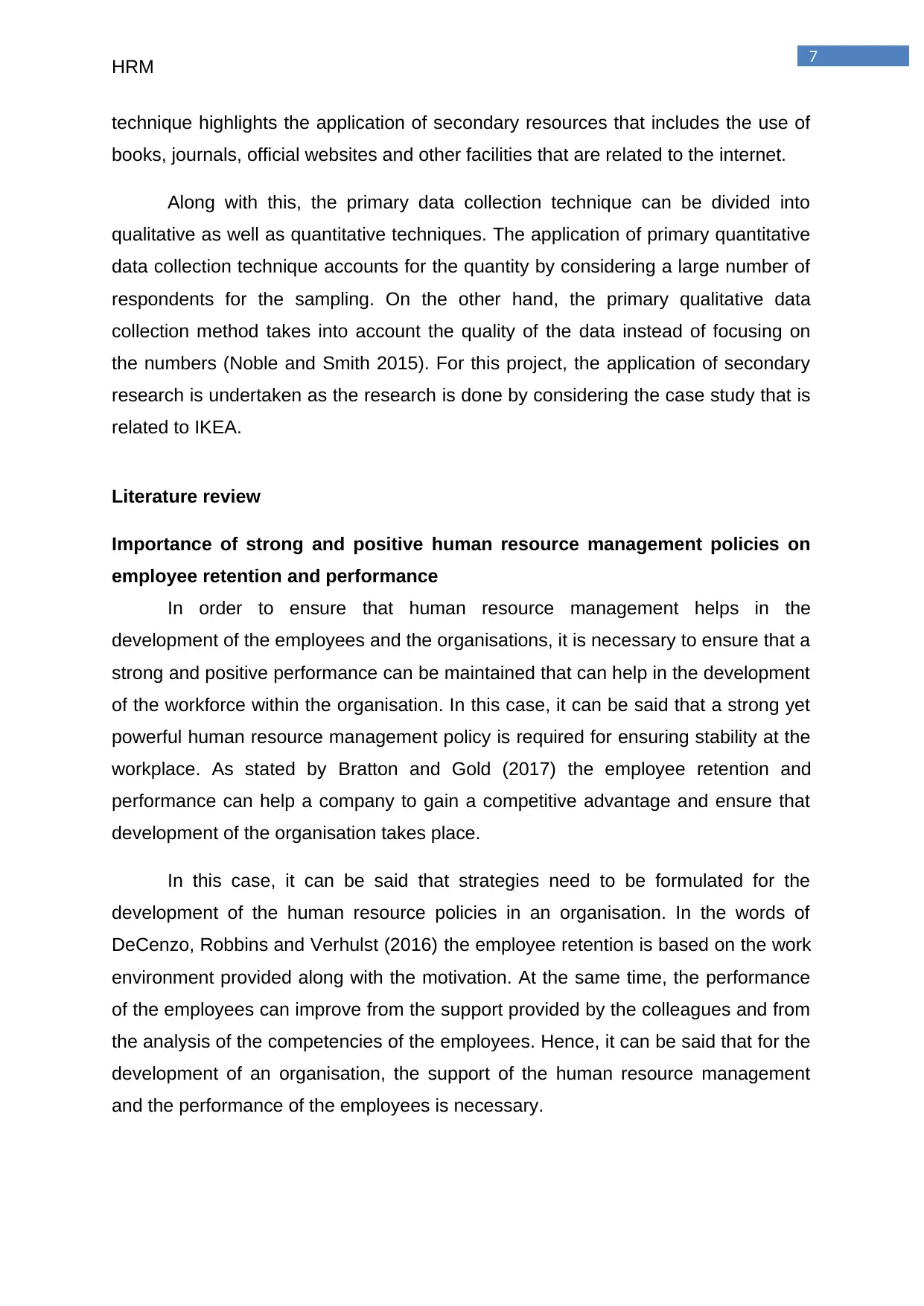
7
HRM
technique highlights the application of secondary resources that includes the use of
books, journals, official websites and other facilities that are related to the internet.
Along with this, the primary data collection technique can be divided into
qualitative as well as quantitative techniques. The application of primary quantitative
data collection technique accounts for the quantity by considering a large number of
respondents for the sampling. On the other hand, the primary qualitative data
collection method takes into account the quality of the data instead of focusing on
the numbers (Noble and Smith 2015). For this project, the application of secondary
research is undertaken as the research is done by considering the case study that is
related to IKEA.
Literature review
Importance of strong and positive human resource management policies on
employee retention and performance
In order to ensure that human resource management helps in the
development of the employees and the organisations, it is necessary to ensure that a
strong and positive performance can be maintained that can help in the development
of the workforce within the organisation. In this case, it can be said that a strong yet
powerful human resource management policy is required for ensuring stability at the
workplace. As stated by Bratton and Gold (2017) the employee retention and
performance can help a company to gain a competitive advantage and ensure that
development of the organisation takes place.
In this case, it can be said that strategies need to be formulated for the
development of the human resource policies in an organisation. In the words of
DeCenzo, Robbins and Verhulst (2016) the employee retention is based on the work
environment provided along with the motivation. At the same time, the performance
of the employees can improve from the support provided by the colleagues and from
the analysis of the competencies of the employees. Hence, it can be said that for the
development of an organisation, the support of the human resource management
and the performance of the employees is necessary.
HRM
technique highlights the application of secondary resources that includes the use of
books, journals, official websites and other facilities that are related to the internet.
Along with this, the primary data collection technique can be divided into
qualitative as well as quantitative techniques. The application of primary quantitative
data collection technique accounts for the quantity by considering a large number of
respondents for the sampling. On the other hand, the primary qualitative data
collection method takes into account the quality of the data instead of focusing on
the numbers (Noble and Smith 2015). For this project, the application of secondary
research is undertaken as the research is done by considering the case study that is
related to IKEA.
Literature review
Importance of strong and positive human resource management policies on
employee retention and performance
In order to ensure that human resource management helps in the
development of the employees and the organisations, it is necessary to ensure that a
strong and positive performance can be maintained that can help in the development
of the workforce within the organisation. In this case, it can be said that a strong yet
powerful human resource management policy is required for ensuring stability at the
workplace. As stated by Bratton and Gold (2017) the employee retention and
performance can help a company to gain a competitive advantage and ensure that
development of the organisation takes place.
In this case, it can be said that strategies need to be formulated for the
development of the human resource policies in an organisation. In the words of
DeCenzo, Robbins and Verhulst (2016) the employee retention is based on the work
environment provided along with the motivation. At the same time, the performance
of the employees can improve from the support provided by the colleagues and from
the analysis of the competencies of the employees. Hence, it can be said that for the
development of an organisation, the support of the human resource management
and the performance of the employees is necessary.
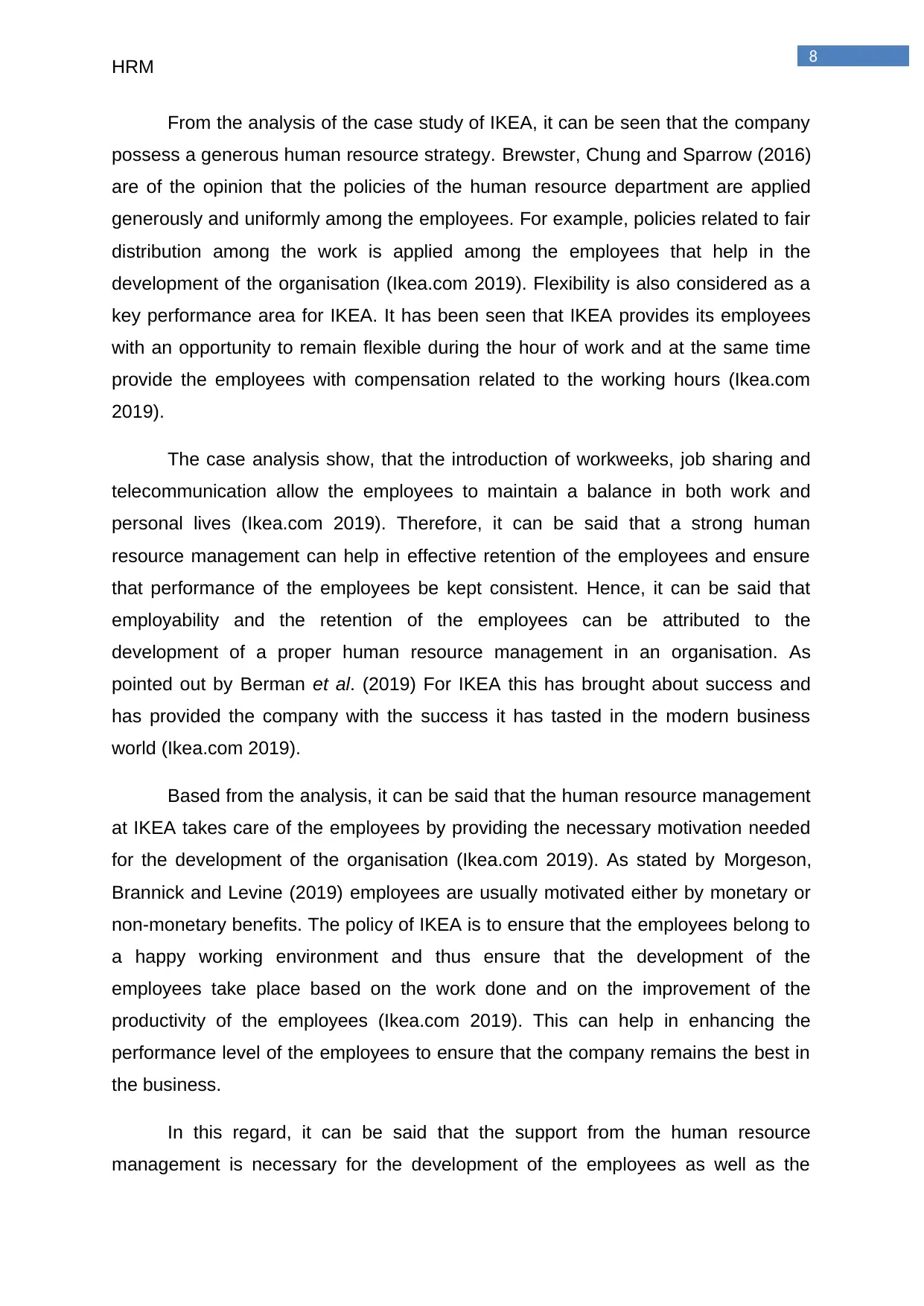
8
HRM
From the analysis of the case study of IKEA, it can be seen that the company
possess a generous human resource strategy. Brewster, Chung and Sparrow (2016)
are of the opinion that the policies of the human resource department are applied
generously and uniformly among the employees. For example, policies related to fair
distribution among the work is applied among the employees that help in the
development of the organisation (Ikea.com 2019). Flexibility is also considered as a
key performance area for IKEA. It has been seen that IKEA provides its employees
with an opportunity to remain flexible during the hour of work and at the same time
provide the employees with compensation related to the working hours (Ikea.com
2019).
The case analysis show, that the introduction of workweeks, job sharing and
telecommunication allow the employees to maintain a balance in both work and
personal lives (Ikea.com 2019). Therefore, it can be said that a strong human
resource management can help in effective retention of the employees and ensure
that performance of the employees be kept consistent. Hence, it can be said that
employability and the retention of the employees can be attributed to the
development of a proper human resource management in an organisation. As
pointed out by Berman et al. (2019) For IKEA this has brought about success and
has provided the company with the success it has tasted in the modern business
world (Ikea.com 2019).
Based from the analysis, it can be said that the human resource management
at IKEA takes care of the employees by providing the necessary motivation needed
for the development of the organisation (Ikea.com 2019). As stated by Morgeson,
Brannick and Levine (2019) employees are usually motivated either by monetary or
non-monetary benefits. The policy of IKEA is to ensure that the employees belong to
a happy working environment and thus ensure that the development of the
employees take place based on the work done and on the improvement of the
productivity of the employees (Ikea.com 2019). This can help in enhancing the
performance level of the employees to ensure that the company remains the best in
the business.
In this regard, it can be said that the support from the human resource
management is necessary for the development of the employees as well as the
HRM
From the analysis of the case study of IKEA, it can be seen that the company
possess a generous human resource strategy. Brewster, Chung and Sparrow (2016)
are of the opinion that the policies of the human resource department are applied
generously and uniformly among the employees. For example, policies related to fair
distribution among the work is applied among the employees that help in the
development of the organisation (Ikea.com 2019). Flexibility is also considered as a
key performance area for IKEA. It has been seen that IKEA provides its employees
with an opportunity to remain flexible during the hour of work and at the same time
provide the employees with compensation related to the working hours (Ikea.com
2019).
The case analysis show, that the introduction of workweeks, job sharing and
telecommunication allow the employees to maintain a balance in both work and
personal lives (Ikea.com 2019). Therefore, it can be said that a strong human
resource management can help in effective retention of the employees and ensure
that performance of the employees be kept consistent. Hence, it can be said that
employability and the retention of the employees can be attributed to the
development of a proper human resource management in an organisation. As
pointed out by Berman et al. (2019) For IKEA this has brought about success and
has provided the company with the success it has tasted in the modern business
world (Ikea.com 2019).
Based from the analysis, it can be said that the human resource management
at IKEA takes care of the employees by providing the necessary motivation needed
for the development of the organisation (Ikea.com 2019). As stated by Morgeson,
Brannick and Levine (2019) employees are usually motivated either by monetary or
non-monetary benefits. The policy of IKEA is to ensure that the employees belong to
a happy working environment and thus ensure that the development of the
employees take place based on the work done and on the improvement of the
productivity of the employees (Ikea.com 2019). This can help in enhancing the
performance level of the employees to ensure that the company remains the best in
the business.
In this regard, it can be said that the support from the human resource
management is necessary for the development of the employees as well as the
⊘ This is a preview!⊘
Do you want full access?
Subscribe today to unlock all pages.

Trusted by 1+ million students worldwide
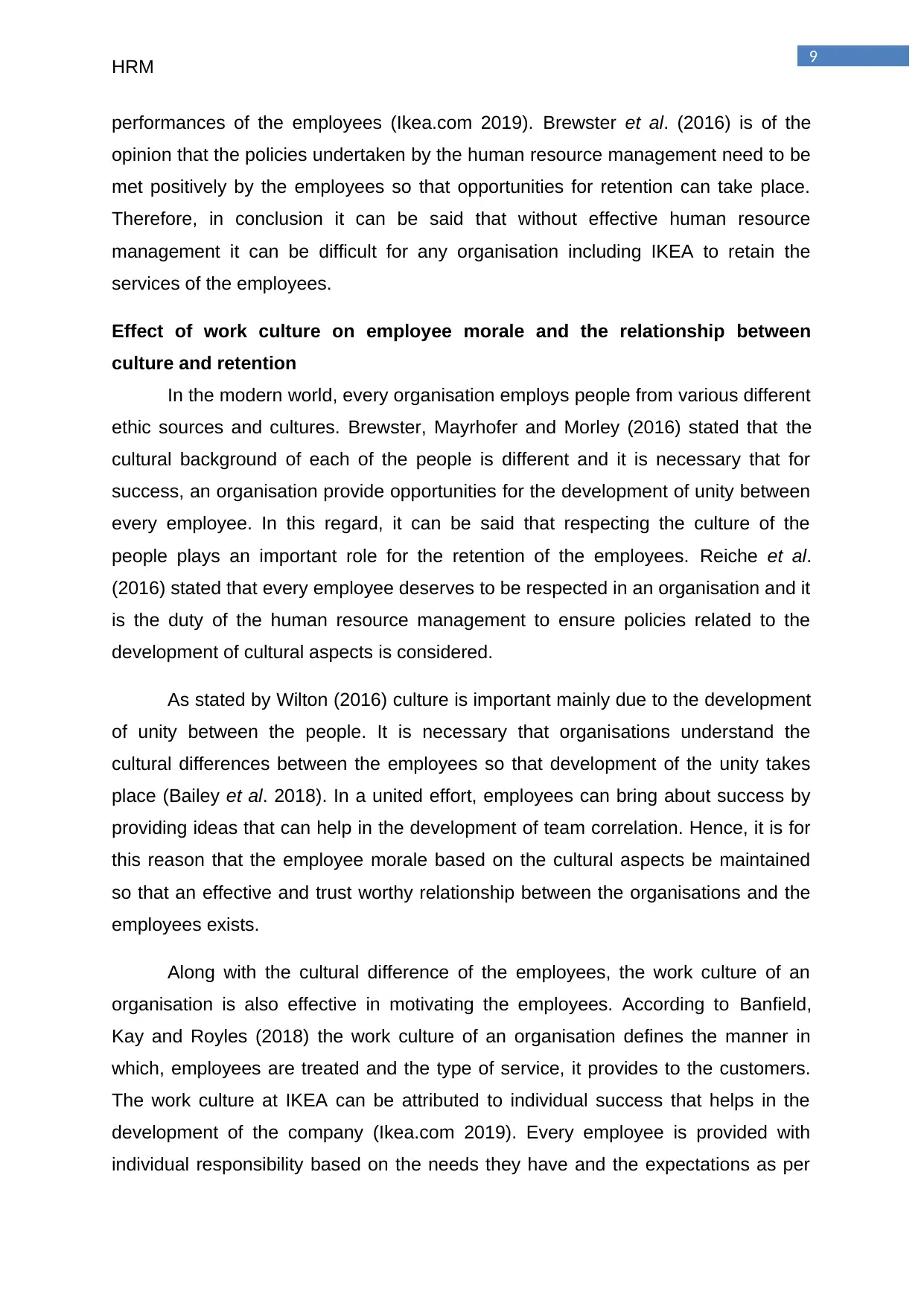
9
HRM
performances of the employees (Ikea.com 2019). Brewster et al. (2016) is of the
opinion that the policies undertaken by the human resource management need to be
met positively by the employees so that opportunities for retention can take place.
Therefore, in conclusion it can be said that without effective human resource
management it can be difficult for any organisation including IKEA to retain the
services of the employees.
Effect of work culture on employee morale and the relationship between
culture and retention
In the modern world, every organisation employs people from various different
ethic sources and cultures. Brewster, Mayrhofer and Morley (2016) stated that the
cultural background of each of the people is different and it is necessary that for
success, an organisation provide opportunities for the development of unity between
every employee. In this regard, it can be said that respecting the culture of the
people plays an important role for the retention of the employees. Reiche et al.
(2016) stated that every employee deserves to be respected in an organisation and it
is the duty of the human resource management to ensure policies related to the
development of cultural aspects is considered.
As stated by Wilton (2016) culture is important mainly due to the development
of unity between the people. It is necessary that organisations understand the
cultural differences between the employees so that development of the unity takes
place (Bailey et al. 2018). In a united effort, employees can bring about success by
providing ideas that can help in the development of team correlation. Hence, it is for
this reason that the employee morale based on the cultural aspects be maintained
so that an effective and trust worthy relationship between the organisations and the
employees exists.
Along with the cultural difference of the employees, the work culture of an
organisation is also effective in motivating the employees. According to Banfield,
Kay and Royles (2018) the work culture of an organisation defines the manner in
which, employees are treated and the type of service, it provides to the customers.
The work culture at IKEA can be attributed to individual success that helps in the
development of the company (Ikea.com 2019). Every employee is provided with
individual responsibility based on the needs they have and the expectations as per
HRM
performances of the employees (Ikea.com 2019). Brewster et al. (2016) is of the
opinion that the policies undertaken by the human resource management need to be
met positively by the employees so that opportunities for retention can take place.
Therefore, in conclusion it can be said that without effective human resource
management it can be difficult for any organisation including IKEA to retain the
services of the employees.
Effect of work culture on employee morale and the relationship between
culture and retention
In the modern world, every organisation employs people from various different
ethic sources and cultures. Brewster, Mayrhofer and Morley (2016) stated that the
cultural background of each of the people is different and it is necessary that for
success, an organisation provide opportunities for the development of unity between
every employee. In this regard, it can be said that respecting the culture of the
people plays an important role for the retention of the employees. Reiche et al.
(2016) stated that every employee deserves to be respected in an organisation and it
is the duty of the human resource management to ensure policies related to the
development of cultural aspects is considered.
As stated by Wilton (2016) culture is important mainly due to the development
of unity between the people. It is necessary that organisations understand the
cultural differences between the employees so that development of the unity takes
place (Bailey et al. 2018). In a united effort, employees can bring about success by
providing ideas that can help in the development of team correlation. Hence, it is for
this reason that the employee morale based on the cultural aspects be maintained
so that an effective and trust worthy relationship between the organisations and the
employees exists.
Along with the cultural difference of the employees, the work culture of an
organisation is also effective in motivating the employees. According to Banfield,
Kay and Royles (2018) the work culture of an organisation defines the manner in
which, employees are treated and the type of service, it provides to the customers.
The work culture at IKEA can be attributed to individual success that helps in the
development of the company (Ikea.com 2019). Every employee is provided with
individual responsibility based on the needs they have and the expectations as per
Paraphrase This Document
Need a fresh take? Get an instant paraphrase of this document with our AI Paraphraser
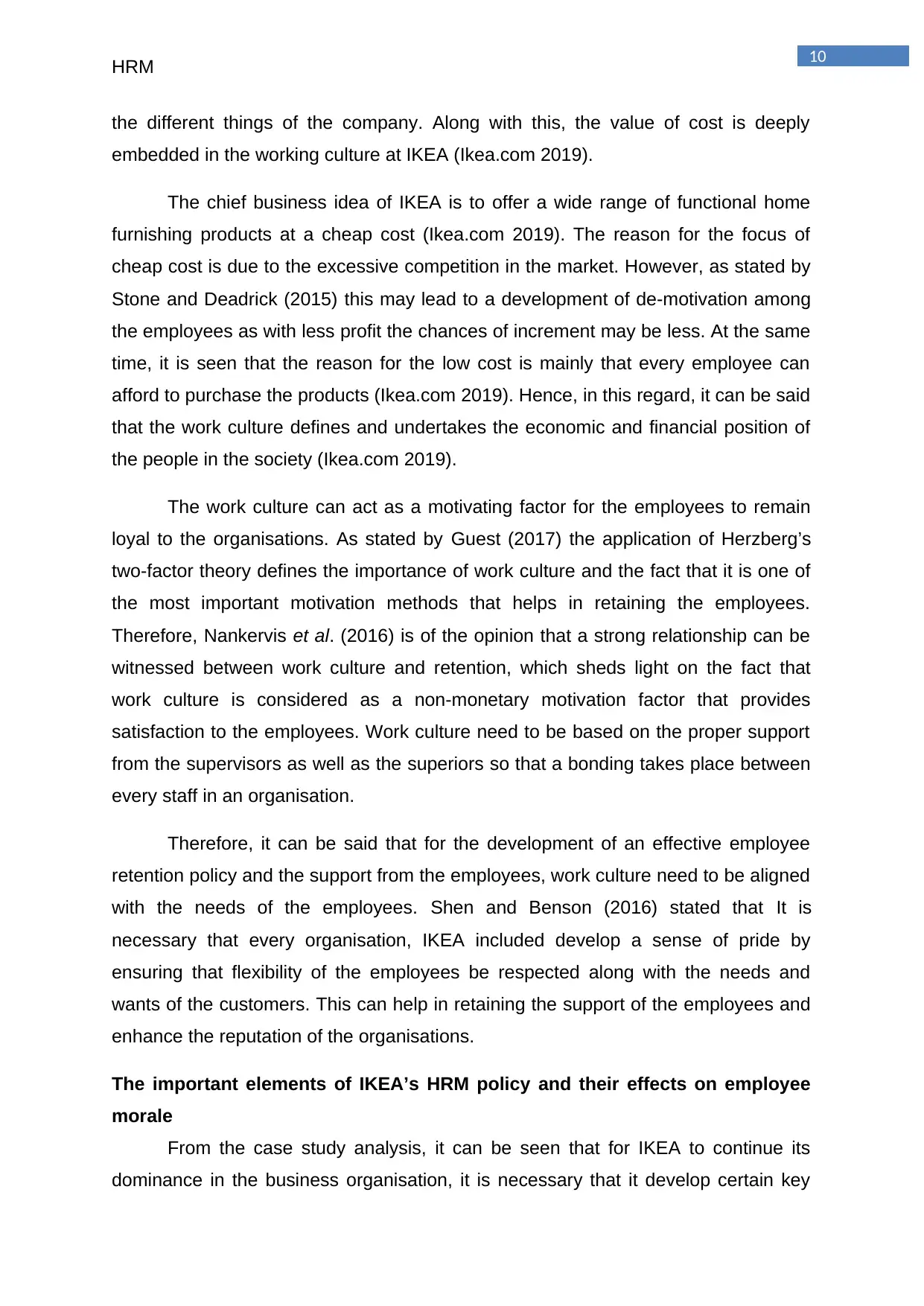
10
HRM
the different things of the company. Along with this, the value of cost is deeply
embedded in the working culture at IKEA (Ikea.com 2019).
The chief business idea of IKEA is to offer a wide range of functional home
furnishing products at a cheap cost (Ikea.com 2019). The reason for the focus of
cheap cost is due to the excessive competition in the market. However, as stated by
Stone and Deadrick (2015) this may lead to a development of de-motivation among
the employees as with less profit the chances of increment may be less. At the same
time, it is seen that the reason for the low cost is mainly that every employee can
afford to purchase the products (Ikea.com 2019). Hence, in this regard, it can be said
that the work culture defines and undertakes the economic and financial position of
the people in the society (Ikea.com 2019).
The work culture can act as a motivating factor for the employees to remain
loyal to the organisations. As stated by Guest (2017) the application of Herzberg’s
two-factor theory defines the importance of work culture and the fact that it is one of
the most important motivation methods that helps in retaining the employees.
Therefore, Nankervis et al. (2016) is of the opinion that a strong relationship can be
witnessed between work culture and retention, which sheds light on the fact that
work culture is considered as a non-monetary motivation factor that provides
satisfaction to the employees. Work culture need to be based on the proper support
from the supervisors as well as the superiors so that a bonding takes place between
every staff in an organisation.
Therefore, it can be said that for the development of an effective employee
retention policy and the support from the employees, work culture need to be aligned
with the needs of the employees. Shen and Benson (2016) stated that It is
necessary that every organisation, IKEA included develop a sense of pride by
ensuring that flexibility of the employees be respected along with the needs and
wants of the customers. This can help in retaining the support of the employees and
enhance the reputation of the organisations.
The important elements of IKEA’s HRM policy and their effects on employee
morale
From the case study analysis, it can be seen that for IKEA to continue its
dominance in the business organisation, it is necessary that it develop certain key
HRM
the different things of the company. Along with this, the value of cost is deeply
embedded in the working culture at IKEA (Ikea.com 2019).
The chief business idea of IKEA is to offer a wide range of functional home
furnishing products at a cheap cost (Ikea.com 2019). The reason for the focus of
cheap cost is due to the excessive competition in the market. However, as stated by
Stone and Deadrick (2015) this may lead to a development of de-motivation among
the employees as with less profit the chances of increment may be less. At the same
time, it is seen that the reason for the low cost is mainly that every employee can
afford to purchase the products (Ikea.com 2019). Hence, in this regard, it can be said
that the work culture defines and undertakes the economic and financial position of
the people in the society (Ikea.com 2019).
The work culture can act as a motivating factor for the employees to remain
loyal to the organisations. As stated by Guest (2017) the application of Herzberg’s
two-factor theory defines the importance of work culture and the fact that it is one of
the most important motivation methods that helps in retaining the employees.
Therefore, Nankervis et al. (2016) is of the opinion that a strong relationship can be
witnessed between work culture and retention, which sheds light on the fact that
work culture is considered as a non-monetary motivation factor that provides
satisfaction to the employees. Work culture need to be based on the proper support
from the supervisors as well as the superiors so that a bonding takes place between
every staff in an organisation.
Therefore, it can be said that for the development of an effective employee
retention policy and the support from the employees, work culture need to be aligned
with the needs of the employees. Shen and Benson (2016) stated that It is
necessary that every organisation, IKEA included develop a sense of pride by
ensuring that flexibility of the employees be respected along with the needs and
wants of the customers. This can help in retaining the support of the employees and
enhance the reputation of the organisations.
The important elements of IKEA’s HRM policy and their effects on employee
morale
From the case study analysis, it can be seen that for IKEA to continue its
dominance in the business organisation, it is necessary that it develop certain key
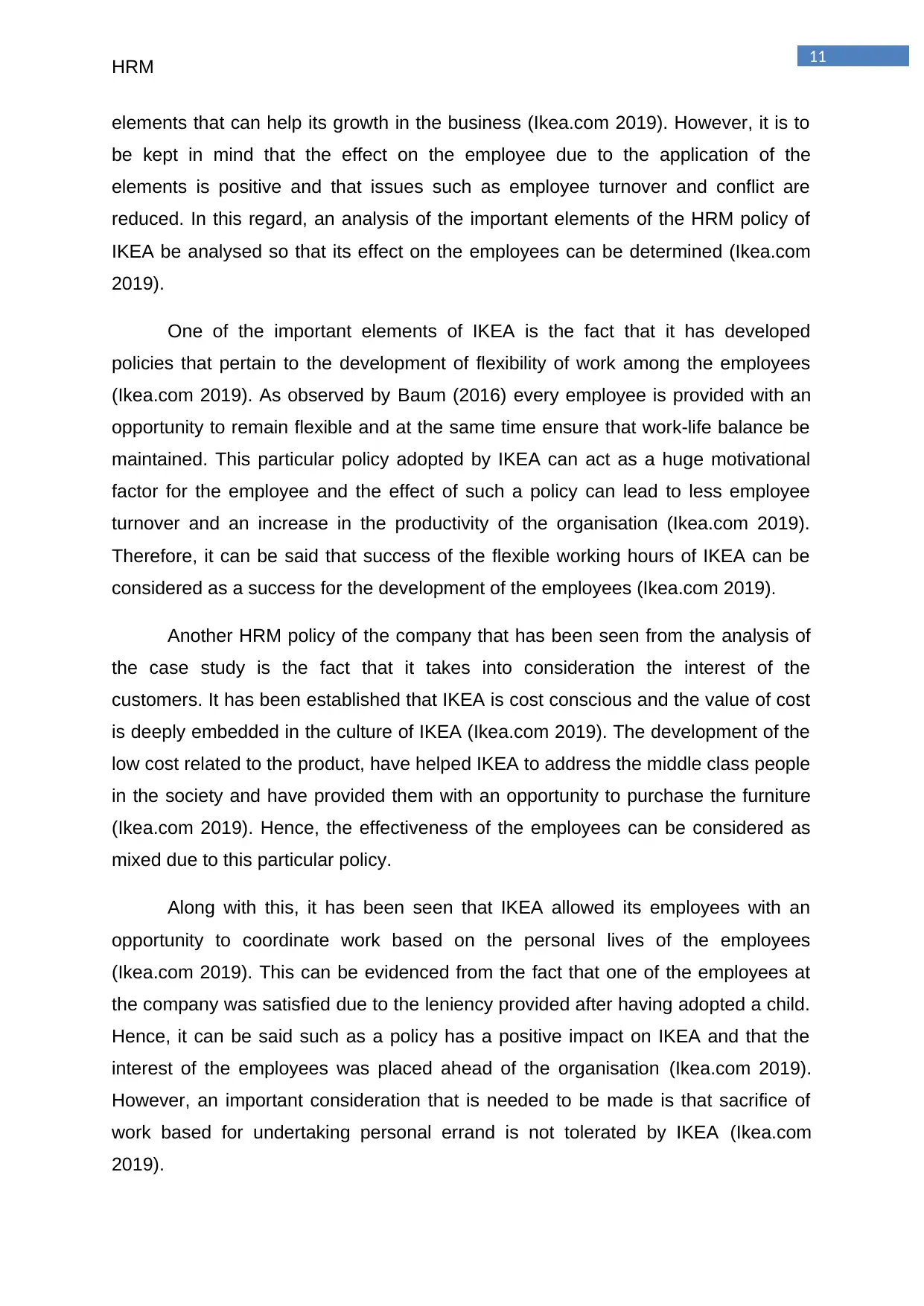
11
HRM
elements that can help its growth in the business (Ikea.com 2019). However, it is to
be kept in mind that the effect on the employee due to the application of the
elements is positive and that issues such as employee turnover and conflict are
reduced. In this regard, an analysis of the important elements of the HRM policy of
IKEA be analysed so that its effect on the employees can be determined (Ikea.com
2019).
One of the important elements of IKEA is the fact that it has developed
policies that pertain to the development of flexibility of work among the employees
(Ikea.com 2019). As observed by Baum (2016) every employee is provided with an
opportunity to remain flexible and at the same time ensure that work-life balance be
maintained. This particular policy adopted by IKEA can act as a huge motivational
factor for the employee and the effect of such a policy can lead to less employee
turnover and an increase in the productivity of the organisation (Ikea.com 2019).
Therefore, it can be said that success of the flexible working hours of IKEA can be
considered as a success for the development of the employees (Ikea.com 2019).
Another HRM policy of the company that has been seen from the analysis of
the case study is the fact that it takes into consideration the interest of the
customers. It has been established that IKEA is cost conscious and the value of cost
is deeply embedded in the culture of IKEA (Ikea.com 2019). The development of the
low cost related to the product, have helped IKEA to address the middle class people
in the society and have provided them with an opportunity to purchase the furniture
(Ikea.com 2019). Hence, the effectiveness of the employees can be considered as
mixed due to this particular policy.
Along with this, it has been seen that IKEA allowed its employees with an
opportunity to coordinate work based on the personal lives of the employees
(Ikea.com 2019). This can be evidenced from the fact that one of the employees at
the company was satisfied due to the leniency provided after having adopted a child.
Hence, it can be said such as a policy has a positive impact on IKEA and that the
interest of the employees was placed ahead of the organisation (Ikea.com 2019).
However, an important consideration that is needed to be made is that sacrifice of
work based for undertaking personal errand is not tolerated by IKEA (Ikea.com
2019).
HRM
elements that can help its growth in the business (Ikea.com 2019). However, it is to
be kept in mind that the effect on the employee due to the application of the
elements is positive and that issues such as employee turnover and conflict are
reduced. In this regard, an analysis of the important elements of the HRM policy of
IKEA be analysed so that its effect on the employees can be determined (Ikea.com
2019).
One of the important elements of IKEA is the fact that it has developed
policies that pertain to the development of flexibility of work among the employees
(Ikea.com 2019). As observed by Baum (2016) every employee is provided with an
opportunity to remain flexible and at the same time ensure that work-life balance be
maintained. This particular policy adopted by IKEA can act as a huge motivational
factor for the employee and the effect of such a policy can lead to less employee
turnover and an increase in the productivity of the organisation (Ikea.com 2019).
Therefore, it can be said that success of the flexible working hours of IKEA can be
considered as a success for the development of the employees (Ikea.com 2019).
Another HRM policy of the company that has been seen from the analysis of
the case study is the fact that it takes into consideration the interest of the
customers. It has been established that IKEA is cost conscious and the value of cost
is deeply embedded in the culture of IKEA (Ikea.com 2019). The development of the
low cost related to the product, have helped IKEA to address the middle class people
in the society and have provided them with an opportunity to purchase the furniture
(Ikea.com 2019). Hence, the effectiveness of the employees can be considered as
mixed due to this particular policy.
Along with this, it has been seen that IKEA allowed its employees with an
opportunity to coordinate work based on the personal lives of the employees
(Ikea.com 2019). This can be evidenced from the fact that one of the employees at
the company was satisfied due to the leniency provided after having adopted a child.
Hence, it can be said such as a policy has a positive impact on IKEA and that the
interest of the employees was placed ahead of the organisation (Ikea.com 2019).
However, an important consideration that is needed to be made is that sacrifice of
work based for undertaking personal errand is not tolerated by IKEA (Ikea.com
2019).
⊘ This is a preview!⊘
Do you want full access?
Subscribe today to unlock all pages.

Trusted by 1+ million students worldwide
1 out of 24
Related Documents
Your All-in-One AI-Powered Toolkit for Academic Success.
+13062052269
info@desklib.com
Available 24*7 on WhatsApp / Email
![[object Object]](/_next/static/media/star-bottom.7253800d.svg)
Unlock your academic potential
Copyright © 2020–2025 A2Z Services. All Rights Reserved. Developed and managed by ZUCOL.




